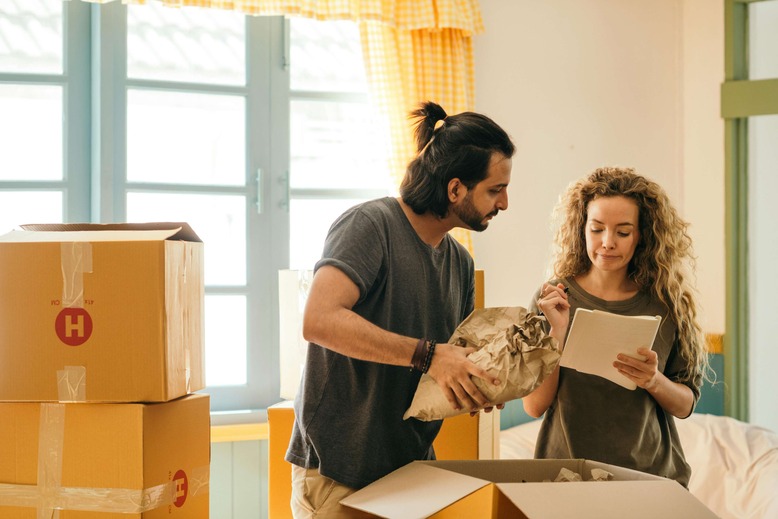Easiest Way to Pack and Move: Tips for a Smooth Transition
Get Your Free Moving Estimate
Moving to a new home can feel daunting, but it doesn’t have to be. With our guide on the easiest way to pack and move, you can embark on your relocation journey with confidence. We understand that a smooth transition to a new home requires careful planning and an organized moving strategy. Here, we will share practical tips to ensure a stress-free move, from prioritizing your tasks to packing efficiently. At Heavenly Move, our mission is to provide you with an exceptional moving experience, built on expertise and customer-focused service.
Key Takeaways
- Planning is critical for a smooth transition to your new home.
- Establish a clear timeline to stay organized throughout the moving process.
- Gather essential packing supplies in advance to avoid last-minute stress.
- Declutter your belongings to make packing and unpacking easier.
- Consider hiring professionals if you need assistance with heavy or fragile items.
- DIY moving options can be budget-friendly and effective if planned properly.
- Create a checklist for moving day to ensure nothing is overlooked.
Understanding the Importance of Planning
Effective planning is the backbone of any efficient relocation. By understanding the significance of an organized moving strategy, we can approach the process with clarity and purpose. Establishing a well-defined plan ensures we allocate time wisely, facilitating a smoother experience and reducing chaos during the move.
Why Planning Makes a Difference
When we prioritize planning, we outline our main objectives and create a timeline. This structured approach allows for:
- Minimized last-minute rush: An organized moving strategy protects us from unnecessary stress.
- Improved communication: Everyone involved understands their responsibilities and timelines.
- Efficiency: A well-thought-out plan helps us manage tasks systematically, ensuring organized execution of each step.
Common Risks of Poor Planning
Neglecting the planning importance can lead to significant setbacks. Common risks include:
- Lost items: Without a thorough inventory, valuable belongings may go missing.
- Delays: Poor coordination often results in unexpected hold-ups.
- Increased stress: Lack of preparation amplifies anxiety, making the entire process more challenging.
Incorporating an organized moving strategy ensures a smoother transition, making the relocation experience enjoyable rather than overwhelming.
Creating a Packing Timeline
A well-structured packing timeline is vital for an effective move. By breaking down tasks into manageable segments, we can set specific deadlines that help us stay organized and keep track of our progress. This approach allows us to focus on individual tasks without feeling overwhelmed.
Setting Deadlines for Each Task
Establishing clear deadlines contributes significantly to our overall moving strategy. Here are some practical moving advice tips to set your packing schedule:
- List all packing tasks, such as sorting, packing, and labeling.
- Assign a deadline for each task to ensure timely completion.
- Prioritize items based on how frequently they’re used. For example, pack seasonal items first.
Adjusting Your Timeline as Needed
Flexibility can be just as important as planning. Adjusting our timeline can help us accommodate unexpected changes. Here are some moving hacks to keep in mind:
- Regularly review your timeline and make modifications based on your progress.
- Stay open to shifting deadlines if life events interfere with your plans.
- Communicate with all team members involved in the move to ensure everyone stays informed about any changes.
| Task | Recommended Deadline | Notes |
|---|---|---|
| Sort and Declutter | 2-3 Weeks Before Move | Identify items to donate, sell, or discard. |
| Gather Packing Supplies | 2 Weeks Before Move | Ensure you have boxes, tape, and packing materials. |
| Pack Non-Essentials | 1-2 Weeks Before Move | Focus on items used less frequently. |
| Pack Essentials | 1-2 Days Before Move | Keep these items accessible for the big day. |
Gathering Packing Supplies
To embark on our moving journey, having the right packing supplies is essential. Gathering the necessary materials in advance enables us to implement hassle-free packing techniques seamlessly. Our focus should be on securing items that can protect our belongings during the move.
Essential Packing Materials to Have
Before we start packing, let’s outline the critical materials we will need:
- Sturdy boxes in various sizes
- Packing tape for securing boxes
- Bubble wrap to protect fragile items
- Markers for labeling boxes
- Plastic wrap for securing loose items
- Fish line for hanging items
These essentials create a reliable inventory, ensuring a smooth moving process.
Where to Find Affordable Supplies
Finding affordable packing supplies is key to managing our budget. Many options are available:
- Local retail stores often have sales or discounted items.
- Online retailers like Amazon provide a wide range of options.
- Consider borrowing boxes from friends or family who have recently moved.
- Secondhand store options can offer unique finds and cost savings.
By exploring these avenues, we can efficiently gather the necessary materials without overspending, making our relocation as smooth as possible.
Decluttering Before You Pack
Before we start packing, it’s essential to assess our belongings. Decluttering is more than just a buzzword; it offers numerous benefits that significantly ease the moving process. By intentionally eliminating items we no longer use, we not only lighten our load but also create a more organized environment in our new home.
Benefits of Decluttering
Understanding the benefits of decluttering can motivate us to tackle this important step. Here are some key advantages:
- Reduced packing load: Less stuff means fewer boxes and less hassle.
- Time savings: Fewer items to sort and pack translates to a more expedited process.
- Less stress: A decluttered space can lead to a clearer mind, making the move feel more manageable.
- Increased focus: Streamlining belongings allows us to prioritize what truly matters.
How to Decide What to Keep
Determining what to keep can be challenging. A thoughtful approach makes this process smoother. We recommend the following criteria:
| Criteria | Questions to Consider |
|---|---|
| Utility | Have I used this item in the last year? |
| Sentimental Value | Does this item hold significant memories or emotions? |
| Condition | Is this item in good shape, or is it beyond repair? |
| Replacement Cost | Would it be expensive or difficult to replace this item? |
By applying these questions, we ensure a focused and purposeful approach to packing, ultimately leading to a more streamlined moving process.
Packing Room by Room
Packing room by room provides a systematic approach, ensuring we tackle each area efficiently while maintaining an organized moving strategy. This method enables us to concentrate on one space at a time, reducing the chaos often associated with moving. By starting with the least-used rooms, we can progressively handle the essentials as moving day approaches.
Tips for Efficient Room Packing
To enhance your efficiency when packing, consider these strategies:
- Begin with unused items: Start with rooms or spaces that you rarely use, such as guest rooms or storage areas.
- Prioritize essentials: As moving day nears, shift focus to packing items that are used regularly, such as your kitchen and living room.
- Utilize packing materials wisely: Use boxes of various sizes and secure materials like bubble wrap or packing paper for fragile items.
- Maintain an organized system: Keep similar items together within each room, making it easier to unpack later.
How to Label Boxes Effectively
Labeling boxes plays a crucial role in our organized moving strategy. Here are some effective methods:
- Clear descriptions: Write down the main content of the box and its destination room. This will expedite the unpacking process.
- Color-coding: Assign colors to different rooms or categories, helping us quickly identify where boxes belong.
- Use heavy-duty markers: Ensure labels are visible and legible from a distance.
| Labeling Method | Benefit |
|---|---|
| Clear Descriptions | Facilitates quick identification of box contents. |
| Color-Coding | Streamlines unpacking and organization in new space. |
| Heavy-Duty Markers | Ensures labels remain intact and legible during transit. |
Implementing these tips will significantly enhance our efficiency and effectiveness during the moving process, ensuring a smooth transition to our new home or business location.
Fragile Items: Best Packing Practices
Packing fragile items requires careful attention to detail to ensure their safety during transport. Effective fragile items packing can prevent breakage and damages that can lead to unnecessary loss. Here are essential packing tips for different types of fragile items.
Packing Glass and Ceramics
When handling glass and ceramics, our top recommendations include:
- Use ample bubble wrap to protect each individual item.
- Consider double boxing for extra security—place the wrapped item in a sturdy box, and then put that box inside a larger one with additional packing material.
- Fill any empty spaces with packing peanuts or crumpled paper to minimize movement during transit.
- Clearly label the outer box as “Fragile” to inform anyone handling it to take extra care.
Tips for Electronics and Appliances
Electronics and appliances require specialized handling to ensure they remain intact throughout the moving process. Here are crucial packing tips:
- Before packing, power down and disconnect all devices from their power sources.
- Utilize original boxes whenever possible, as they are specifically designed for the protection of these items.
- Wrap each device in a soft cloth or foam padding before placing it in the box.
- Label cables and components clearly, so reassembly is easy in your new location.
By following these practices, we can help ensure your fragile items reach their destination safely and securely, making the moving process much smoother.
Using Packing Techniques for Efficiency

Employing effective packing techniques can significantly enhance our moving experience. Two popular methods stand out for their ability to save space and maintain organization during the moving process. These packing tips and moving hacks can streamline our efforts and simplify the transition to a new home.
The Rolling Method vs. Folding
The rolling method is an excellent option for clothing. This technique minimizes wrinkles while maximizing space within our boxes. Compared to traditional folding, rolling clothes can lead to a more compact arrangement, allowing us to fit more into each box. Here are some advantages of each method:
- Rolling: Reduces wrinkles, creates more space.
- Folding: Suitable for items that maintain structure, stacks neatly.
Vacuum-Sealing for Space Saving
Vacuum-sealing is another efficient packing hack that can dramatically reduce bulk. This method is particularly useful for bedding, seasonal clothing, and soft furnishings. By removing air from the bags, we create a streamlined package that takes up less room.
Consider the following benefits of vacuum-sealing:
- Space Efficiency: Up to 75% reduction in volume.
- Protection: Guards against moisture, dirt, and pests.
Incorporating these packing techniques not only makes our move smoother but also helps maintain our sanity in a busy time. Efficient packing sets the stage for a successful transition to our new space.
Hiring Professional Movers
When the moving process feels overwhelming, hiring professional movers can make a significant difference. We understand that relocating involves more than just packing boxes. The logistics can become complex, and if we find ourselves short on time or energy, seeking professional assistance is a practical choice. This decision not only eases the burden but can lead to a more efficient relocation.
When to Consider Hiring Help
If we have a full schedule, or if the distance between homes is considerable, it may be wise to look into hiring professional movers. Their expertise streamlines the entire process and minimizes potential issues associated with moving heavy furniture or valuable items. Pay attention to signs that indicate the need for assistance, such as:
- Lack of time to organize and pack
- Specialty items that require careful handling
- Long-distance moves where logistics become challenging
Questions to Ask Potential Movers
Choosing the right movers is crucial for an efficient relocation. We should consider asking the following questions to ensure we select a trustworthy service:
- How long has your company been in business?
- Do you have insurance coverage for damaged items?
- Can you provide references or customer reviews?
- What is included in your pricing structure?
- How do you handle fragile or specialty items?
Engaging with professional movers who are responsive and transparent in their processes can lead to a smoother moving experience. We can move forward with confidence, knowing we are making informed choices every step of the way.
DIY Moving Options
Exploring DIY moving options can provide an appealing alternative for those who desire more control over the moving process. Two popular choices involve renting a moving truck and understanding the advantages of a DIY move.
Renting a Moving Truck
When renting a moving truck, we gain the flexibility to choose our schedule and the ability to pack our belongings in our preferred manner. Below are key steps and considerations when opting for this route:
- Choose the right size truck based on the volume of your items.
- Compare rental companies for the best rates and services.
- Ensure you have a valid driver’s license and are comfortable driving a larger vehicle.
- Review insurance options to protect against potential accidents.
Benefits of a DIY Move
Engaging in a DIY move can often result in significant cost savings while allowing for complete control over the moving process. Here are some benefits:
- Cost-effectiveness: Avoiding professional mover fees can reduce overall expenses.
- Personal touch: Handling our belongings with care can prevent damages during transit.
- Time management: We set our own pace and schedule, minimizing stress during the transition.
- Family involvement: Engaging friends and family can transform moving into a collaborative experience.
Approaching a move with practical moving advice will help ensure safety and efficiency, making the DIY process more enjoyable and successful. With careful planning and the right tools, a DIY move can serve as a fulfilling option for many homeowners.
| Advantages | Considerations |
|---|---|
| Cost Savings | Physical Strain and Risk of Injury |
| Flexibility in Timing | Need for Organization and Planning |
| Control over Packing Process | Possible Need for Additional Help |
Preparing for Moving Day
Effective moving day preparation can significantly enhance your transition experience. A structured approach, along with an organized moving strategy, ensures everything is in place when the big day arrives. By carefully planning and creating a checklist of essential tasks, we can maximize efficiency and minimize stress.
Creating a Moving Day Checklist
A moving day checklist is crucial for maintaining organization. This tool keeps track of all tasks and essential details that need attention. Here are components to consider including in our checklist:
- Confirm the arrival time of the moving truck
- Double-check packed boxes and items
- Clear pathways for easy moving
- Ensure utilities are set up at the new address
- Prepare snacks and drinks for the day
Last-Minute Tasks to Complete
As we approach moving day, certain last-minute tasks must be tackled to maintain an organized moving strategy. Consider completing these the night before:
- Verify all necessary paperwork is accessible
- Pack a bag with essentials for the first night
- Disconnect appliances and gadgets
- Secure valuable items and documents
- Conduct a final walk-through of your old home
| Task | Timing | Status |
|---|---|---|
| Confirm Moving Truck | Day Before | Pending |
| Pack Essential Bag | Night Before | Pending |
| Disconnect Appliances | Night Before | Pending |
| Final Walk-through | Day Of | Pending |
| Load Truck | Day Of | Pending |
By prioritizing these tasks and keeping to our moving day preparation checklist, we can ensure a seamless and efficient transition to our new home.
Settling Into Your New Home
As we arrive at our new home, it’s time to focus on the unpacking process. To streamline this phase, we recommend starting with essential items—things like bedding, toiletries, and kitchen necessities. This not only addresses immediate needs but also helps us begin the journey of making our new space feel like home. Following a methodical approach allows us to gradually work through boxes by priority, making the transition smoother.
Unpacking Strategies for a Smooth Setup
Implementing effective unpacking strategies is key for an efficient setup. Prioritize rooms based on your daily routines; for instance, unpacking the kitchen and bedrooms first can help establish comfort quickly. As we tackle each room, clearly labeling boxes during the packing stage aids in swiftly locating items, minimizing frustration during unpacking. The sense of accomplishment we gain from clearing each box enhances our settling-in experience.
Making Your New Space Feel Like Home
To truly make our new space feel like home, we should incorporate personal touches as soon as possible. Hang beloved artwork, arrange personal mementos, and set up comfortable furniture to create a welcoming atmosphere. By intertwining familiar decor with our unique style, we foster a sense of belonging. Ultimately, combining an organized unpacking strategy with personal elements helps ensure we settle into our new home seamlessly and happily.
FAQ
What is the easiest way to pack and move?
How can I create an organized moving strategy?
What packing supplies do I need for a stress-free move?
What are some benefits of decluttering before a move?
How should I pack fragile items like glass and electronics?
When should I consider hiring professional movers?
What are the advantages of renting a moving truck for a DIY move?
How can I prepare for moving day effectively?
What unpacking strategies can help settle into my new home?


